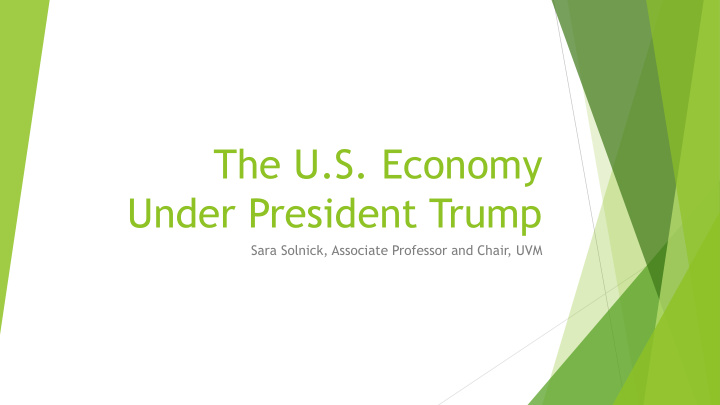



The U.S. Economy Under President Trump Sara Solnick, Associate Professor and Chair, UVM
u GDP u The Labor Market u Inequality u Trade u Immigration u Taxes
Employment by sector over time
Economic growth: What is possible? “To get the economy back on track, President Trump has outlined a bold plan to create 25 million new American jobs in the next decade and return to 4 percent annual economic growth ” whitehouse.gov
What is GDP? u GDP is the total value of goods and services produced. u GDP doesn’t account for what is used up or shortening people’s lives. u If you raise GDP by destroying the environment you’re not really ahead.
How to produce more stuff? Productivity = Output per labor hour u Technological advances u Greater investment in machinery and equipment by businesses u Increases in worker skill and experience
Hours are rising in line with past trends; Output is not à Productivity is not
Can we raise it? NO MAYBE? u 1750 to 2004 was a unique u New firms not being phase of history (Robert created. Gordon) u Workers not moving. u Population is aging. Every u Companies not investing. 10-percent increase in a u We are not measuring share of a state’s growth adequately. For population over the age of example, free apps don’t 60 reduces per capita GDP contribute to GDP . growth by 5.5 percent.
The unemployment rate "I've seen numbers of 24 percent -- I actually saw a number of 42 percent unemployment. Forty-two percent. 5.3 percent unemployment -- that is the biggest joke there is in this country. … The unemployment rate is probably 20 percent, but I will tell you, you have some great economists that will tell you it's a 30, 32. And the highest I've heard so far is 42 percent.” ~ Trump, September 2015
The Labor Market: How many people “should” be working? “210 million adult Americans between the ages of 16 and 68 … amounts to 420 billion potential labor hours, if we accept the convention that all adults are at least theoretically capable of holding a full-time job (2,000 hours/year) and pulling their share of society's need for production and work effort. “By contrast, during 2014 only 240 billion hours were actually supplied to the US economy.” David Stockman, June 2015
Economists: People maximize UTILITY , not income u There is no obligation to work. u Some people are not able to work. u Other choose not to work. Be retired, take care of children or elder family members, volunteer, study, travel, make a documentary film or sit in the park all day.
Unemployment rate over time
Income inequality
Trade
Trade creates better jobs u Workers in manufacturing firms that export generally earn wages 12 to 18 percent higher than their counterparts in firms that only serve the domestic market. u If we cut off trade, we wouldn ’ t make those things ourselves. We just wouldn ’ t have them. u 87% of job loss is due to automation, not trade.
Immigration
Undocumented immigration has been falling
Do fewer immigrants mean more jobs for natives? u In 1964, 97 percent of California tomatoes were picked by hand. u The United States was letting farmers hire Mexican workers on seasonal permits. President Lyndon B. Johnson ended the program in 1964. u By 1966, 90 percent of California tomatoes were being picked by machines.
Wage effects u Immigrants seem to compete mostly with other immigrants, even when controlling for age and education. u One study: between 1990 and 2006 immigration had a small positive effect on the wages of unskilled American- born workers, but reduced the wages of previous generations of migrants by 6.7%. u Another expert’s “worst case”: immigration has cut the wages of high-school dropouts by about 5% over 20 years
How immigrants affect the economy u less-skilled immigrants are also consumers of American- made goods and services u their cheap labor raises economic output and leads to new jobs for natives. u their cheap labor also reduces prices. u their children tend to have substantially more skills. In fact, the children of immigrants contribute more to state fiscal coffers than do other native-born Americans.
Our society attracts the best minds. u Among graduates of American colleges, immigrants are twice as likely to receive patents as native-born Americans. u 40% of Fortune 500 countries founded by immigrants or children of immigrants. u 22% of MacArthur ”Genius Grant” awards won by immigrants. u 35% of John Bates Clark medalists are immigrants. u Immigrants have won more than 100 of the 350 Nobel Prizes won by Americans. If “immigrants to the U.S.” were their own country, they would have won more Nobel Prizes than any other country except the United States itself.
Tax cut? “We are the highest taxed nation in the world.” Trump, September 6, 2017
Does lower corporate tax lead to more jobs? u Study of 92 publicly held American corporations that reported a profit in the United States every year from 2008 through 2015 and paid less than 20 percent of their earnings in federal income tax. u Median job-growth rate over the past nine years was nearly negative 1 percent, compared with 6 percent for the private sector as a whole. Of those 92 companies, 48 got rid of a combined total of 483,000 jobs.
Reasons not to lower the corporate tax u Effect on deficit: higher deficit à higher interest rates u Companies hire if they need workers, not because they have funds. u Funds are already available (low interest rates)
Will tax cuts increase growth? Maybe a little. More money in the hands of consumers increases demand and expenditures. To the extent that tax cuts go to wealthy individuals, the effect is smaller.
What we really need u Education u Infrastructure u Culture of innovation u Good trade relations = a bigger market
Recommend
More recommend